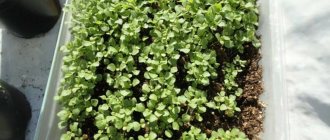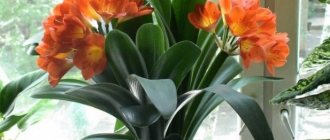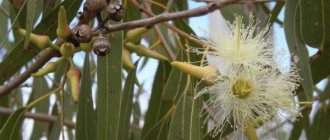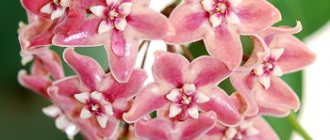How to grow abutilone from seeds at home? Do I need to soak abutilon seeds before planting? Which soil should I choose? When will abutilon seeds germinate? Even a novice gardener can grow abutilone from seeds. After all, this plant is not capricious, responds well to fertilizing, and easily tolerates alkalization of the soil. The gardener will have no problems with germination of seeds, as well as with subsequent picking of seedlings. So, abutilone from seeds - growing at home. Choosing soil, when to sow seeds, when to plant seedlings. Photo instructions and recommendations for growing plants from my personal experience.
Advantages of seed propagation
Fresh seed material of an ornamental plant has very high germination rates , and respect for planting and growing rights allows you to obtain a large amount of healthy and high-quality seedling material.
Currently, breeders and amateur gardeners have produced many interesting varieties of abutilone, so sowing several varieties in one flower pot allows you to create the most interesting and highly decorative flower arrangement. Properly grown from seeds, abutilons have excellent hardiness and are perfectly adapted to growing conditions.
How to grow abutilone in the garden from cuttings
How to grow an abutilon flower from seeds at home
Abutilon cuttings are planted in the garden in open ground when they have formed a sufficiently strong root system. Planting is carried out after the end of spring frosts. The soil for rapid development of cuttings must be nutritious, loose, and well-drained. Abutilons should not be planted in low-lying areas of the garden, where water stagnation in the soil is possible; excessive moisture can cause rotting of young roots and the death of the seedling itself.
For the same reason, plants should be watered moderately and regularly, leaving enough time between waterings for the soil to dry out well. It is recommended to feed flowering seedlings with any complex fertilizer, diluting it in half the dose.
It is preferable to plant abutilon cuttings not directly in open ground, but in containers that can be displayed in the garden in good weather, and when unfavorable conditions occur, brought into a warm, dry room. This method of growing will help protect seedlings from damage by frost, fungal diseases and pests.
Choosing soil and pot
Indoor maple is one of the most unpretentious plants, but to maintain its decorative appearance, it will be necessary to use moisture-permeable, fairly light soil for cultivation. The nutrient soil mixture must include a small amount of perlite or coarse river sand , which will make the soil light and prevent rot from damaging the root system.
As drainage, you can use a layer of expanded clay, small pieces of foam plastic, and relatively small clay shards. The average height of such a layer can be a quarter of the landing capacity. Good results are shown by seeds sown in a ready-made soil substrate for growing palm trees with the addition of perlite or vermiculite. A self-made nutrient substrate should consist of one part of sand, a couple of parts of leaf soil, a couple of parts of humus and four parts of clay turf soil.
6. Signs, useful properties
It is believed that growing this flower at home helps insecure people gain courage; its flowering promotes calm and peace in the home. Bright buds give vigor in the morning and make relationships harmonious, bringing an atmosphere of harmony to the family. This flower is also important for young talents - it is believed that it helps to reveal and develop the talents inherent in a person.
↑ Up,
Among other things, Theophrast abutilon also has healing properties - its juice is used as a wound-healing agent and also helps get rid of the manifestations of furunculosis. Disinfecting and anti-inflammatory properties are also used for diseases of the oral cavity - with the help of a decoction they relieve the symptoms of stomatitis.
The bark of the indoor maple has an astringent and diuretic effect, and the seeds and leaves have laxative, anti-inflammatory and expectorant properties.
Compresses with flower juice are used for burns. It is believed that the juice of the green mass can alleviate the condition of elevated body temperature. The leaves and shoots contain plant antioxidants, as well as substances that help strengthen the immune system and improve liver health.
↑ Up,
How to plant abutilon seeds (video)
It is important to choose the right planting container for sowing and further growing indoor ornamental plants. When growing most varieties and species, preference should be given to medium-sized flower pots. The fast-growing indoor Sello maple requires the deepest and widest container possible , and growing in a container that is too tight often causes shredded foliage and lack of flowering. For slow-growing and compact varieties, the above-ground part of which has shortened internodes, it is best to select a tight pot, which will stimulate the formation of flower buds.
Caring for abutilone at home
Where to choose a place for indoor maple?
Rope is a light-loving flower, so you need to give it a place closer to the window, but direct exposure to sunlight is undesirable. In summer, flower pots can be placed outside, avoiding strong drafts and rain.
Transplantation and how to choose a container
It is important to know that abutilon needs to be replanted every year into a larger container. You cannot use a “growing” pot for this plant; this will delay the growth of green mass and flowering, since the root system cannot be filled with an earthen ball. The capacity is selected slightly larger than the previous one.
Seed preparation and sowing
Sowing work for growing indoor maple can be done almost all year round, but to obtain the highest quality seedling material, it is best to sow the seeds in early spring. For planting, it is recommended to use the largest and most undamaged seeds that have been calibrated and sorted.
Competent pre-sowing preparation, which consists of soaking, is mandatory. It is advisable to distribute the seed onto tissue that is abundantly moistened in a solution based on growth stimulants in the form of humic acids, Epin or Heteroauxin preparations. The average soaking time is about twelve hours , after which the seeds are placed in clean water at room temperature until they swell or germinate. The planting material prepared in this way is sown in a nutrient mixture prepared in advance and disinfected in the oven.
Before sowing, the planting soil must be moistened very well, the seeds must be distributed at a distance of a couple of centimeters from each other and sprinkled with soil, the layer of which should not exceed 5 mm. The container with the crops should be covered with a transparent plastic film and placed in a room with a temperature regime of 20-22°C. Before mass shoots appear, daily ventilation and spraying with settled warm water from a spray bottle are carried out. The average time from sowing to the appearance of seedlings can vary within two to three weeks.
5. Diseases and pests
In general, abutilon gets sick and is attacked by pests quite rarely - mainly due to improper care or inappropriate conditions. Also, leaves and buds may fall off due to sudden temperature changes and changes in light. It is worth accustoming the flower to any changes gradually - over 7 - 10 days.
Twisting and flying of leaf plates will indicate the presence of a cold draft in the room. The tips of the leaves also curl when there is too much light. In insufficient light, the color of the leaves fades.
↑ Up,
With insufficient ventilation and keeping the air cool and high humidity, powdery mildew appears. Frequent and abundant watering, growing in a pot that is too spacious can lead to root rot. Lack of nutrition contributes to less abundant flowering, dropping of buds and their shredding.
Among the pests, the rope plant can be attacked by insects such as spider mites, scale insects, whiteflies, mealybugs or aphids. Sometimes cyclamen mites appear.
↑ Up,
5.1.Why abutilone turns yellow
The leaves turn yellow mainly when there is a lack of light - in this case, you can move the flower to a brighter place or apply additional lighting artificially. The tips of the leaf blades can dry out and turn yellow if there is insufficient air humidity - this is especially true in the cold season when the central heating is on.
The edges of the leaves dry out and turn brown during prolonged drought. Leaves also turn yellow when grown in alkaline soil or lack of iron in the soil. The situation can be corrected by watering with slightly acidified water and spraying the foliage with an iron chelate solution.
Hot summer days can also cause leaves to turn yellow. The edges of the leaf blades turn yellow due to a lack of an element such as magnesium.
↑ Up,
5.2.Why does the plant shed its leaves?
Leaves and buds often fall off when the earthen ball dries out, as well as when the flower is flooded. A too dry atmosphere also negatively affects the rope plant - its leaf blades become curled and may fall off. Increased air temperatures during the dormant period can lead to leaf shedding. Lack of nutrients in the soil contributes to leaf fall.
↑ Up,
Types and varieties of indoor maple
Even without taking into account the varietal diversity, abutilone has many species incarnations. The most common types of indoor maple in indoor culture are:
| Species name | Description |
| Abutilone Hybrid | The species is an American hybrid, characterized by a bush-like plant shape. At home, this species grows up to one and a half meters in height, and its leaves can be either three-lobed or five-lobed. A distinctive feature of hybrid abutilon is slight pubescence of leaves and petioles. The flowers are large, located on very long (up to 20 cm) petioles |
| Abutilone Darwin | The species is considered one of the most attractive due to its amazingly shaped leaves: the upper plates are five-lobed, and on the lower ones the number of blades can reach up to seven. In this case, the central part of the sheet is greatly elongated. Abutilon Darwin's shoots are also beautiful - silky in appearance, they have unsurpassed flexibility, which is why the flower-bearing branches droop beautifully |
| Abutilon Juliet | The most unpretentious type of indoor maple, which is characterized by increased growth and continuous flowering. The leaf blades and shoots are of a typical shape for the genus, and the flowers are large, drooping, and of a wide variety of colors. |
| Abutilon Megapotamian | A very beautiful, sophisticated appearance of indoor maple with drooping thin shoots growing up to 1 meter in length. The flowers resemble Chinese lanterns in shape. Blooms continuously under good growing conditions |
| Abutilon Sello | A hybrid variety of indoor maple with straight, slightly branched shoots and three-lobed leaves. It grows up to 2 meters in height, is distinguished by the variegated color of its leaf blades, with the spots looking like light stripes on a dark green background |
| Abutilon Painted (Spotted) | This indoor maple looks like a compact shrub with soft, non-woody shoots. The leaves of plants of this species are very attractive - they consist of long lobes folded into a five-lobed or six-lobed heart-shaped leaf. The blades are not pubescent, they are smooth and shiny, with white spots located closer to the edge of the leaf. The flower is bell-shaped, with a very long corolla. This species blooms briefly, but very brightly. |
| Abutilon Grape leaf | A tall species, growing up to 2 meters in height or more. The leaves are large, velvety, matte, dark green. The flowers are collected in clusters hanging on elongated petioles. Blooms in spring |
| Abutilon Indian | The species is an annual herbaceous shrub with small bell-shaped flowers and thick, highly pubescent velvety leaves |
Each type of crop is represented by dozens of varieties with different colors and shapes of inflorescences and flowers. The following extraordinary varieties of abutilone are especially popular for growing at home:
| Variety name | Description of flowers and leaves |
| Bella (breeding series) | A compact and very decorative shrub species of indoor maple with a large number of very large flowers that contrast in color with the rich green leaves. The color of the petals is predominantly pastel - peach, pink, light yellow. |
| Kirsche Orange | A compact bush-shaped plant with large orange flowers, corrugated along the edges. |
| Souvenir de Bonn | A low-growing variety that grows up to half a meter in height with variegated leaf blades - dark green with a light, almost white border along the edge |
| White King | A shrub up to 40 cm high with green velvety leaves covered with a bluish coating. The flowers are white, with a bright yellow pistil. |
| Rotterdam | A very bright variety with a lush crown and large fiery red flowers. The pistil is yellow, peeks out a little from behind the petals |
| Large Flowered (breeding series) | A large shrub growing up to 80 cm in height with very large inflorescences on long drooping peduncles. Blooms all year round with proper care. The variety line includes plants with white, pink, orange, red and other flower colors |
| Nabob | The plant is up to one meter high, with solid, rich green leaves and deep red flowers, unusual for an indoor maple. Characterized by long and abundant flowering |
| Royal ilima | Semi-double or double variety with large orange-red flowers and dark green solid leaves |
| White Charm | A variety of grape-leaved abutilon with very large white flowers. The highlight of the variety is its white corolla and incredibly large flower (at least 9 cm in diameter!). The leaves of this variety are similar to the leaf blades of cultivated grapes. |
| Pink Swirls | The most delicate of all indoor maples - with light green foliage and pink flowers, the center of which is decorated with a light pink corolla. |
The varieties presented above are mostly hybrids and are propagated at home by cuttings. To grow one of the described plants, you can also buy seeds. They are sold as a mixture or mix.
Botanical characteristics of abutilone
This plant of the Malvaceae family is an evergreen tree or shrub whose leaves resemble maple leaves in size and shape. This gave abutilone another popular name among the people - indoor maple. In their natural habitat, these plants live in the tropical zones of Africa, South Asia and South America, so the flower loves a lot of light and warmth.
With proper maintenance, it reaches a height of 1.5-2 meters and branches abundantly. The leaves are located on petioles and have a length of 10-20 cm, the leaf blade is oval or heart-shaped, with soft and sparse hairs. Usually the leaves are green in color, but there are varieties with golden-variegated or scarlet colors.
The flowers, similar in shape to a bell, are distinguished by their brightness and variety of shades from white to red. Flowering varies in duration. It occurs from early spring until late autumn. In India, coarse abutilone fiber is used to create burlap, ropes and ropes, so the plant has another name - ropewort.
Photo gallery
Trimming
Since the domestic maple grows quite intensively, it needs frequent trimming, otherwise it will look sloppy. It should be pruned in spring or autumn. If you don’t trim the plant, it will grow about one and a half meters in height.
In addition to corrective pruning, weak, leafy shoots should be removed. If you do not remove bare and weak shoots, the green hair of the tree will look sparse and unkempt.
If you wish, you can form a tree from a bush; to do this, the lower shoots are removed, only the top is left, so it will imitate the crown of a tree.
Growing abutilone "Bella" from seeds
Hybrid Abutilon “Bella-F1” mixture from is especially popular among domestic flower growers. The plant is quite compact in size, and the height of an adult bush rarely exceeds 45 cm. For cultivation, it is necessary to purchase high-quality seed material. The ornamental crop of this series bushes well and begins flowering approximately three months after germination.
Before sowing, seeds must be soaked in water with growth stimulants.
Experienced flower growers recommend cutting the shell slightly. Special peat-humus tablets are best suited for planting:
- the tablet must be soaked in water at room temperature, carefully squeezed out and the non-woven material removed;
- the seed that has swollen and hatched in water must be placed in a recess, after which the tablets must be placed in an indoor mini-greenhouse;
- ventilation is carried out regularly, as well as watering of crops by spraying with warm water;
- after several well-developed leaves have formed on the seedlings, the seedling along with the tablet is placed in an individual flower pot filled with a high-quality nutrient soil mixture.
You can replant a growing ornamental plant as soon as the flower pot becomes crowded. Transplantation is carried out by transferring it into a new flower pot with drainage.
Watering
When the plant begins to actively grow, watering should be regular and plentiful. Having thoroughly soaked the lump of earth with water, you need to wait 2 hours and pour out the excess water from the pan.
From November to February it is necessary to reduce the amount of watering and provide the shrub with a period of rest. Drying, as well as excess moisture, leads to the falling of leaves and flowers.
Aftercare
Despite the fact that abutilons are fairly unpretentious indoor plants, and they are often grown by novice indoor floriculture enthusiasts, the decorative crop should be provided with comfortable conditions:
- the flower pot should be located in a well-lit or slightly shaded place without drafts;
- in summer, it is best to take the indoor plant outside and provide protection from gusts of wind or rain;
- in winter, it is recommended to compensate for insufficient lighting with fluorescent lamps;
- in summer, the optimal temperature for growth and development is 22-25°C, and in winter it is advisable to lower the temperature to 13-15°C;
- In the spring-summer period, indoor maple needs to be provided with abundant watering and spraying, as well as fertilizing with mineral and organic fertilizers twice a month.
In order to create the most lush crown, in early spring, pruning is carried out to ½ of the height of the shoot. Throughout the entire growing season, cleansing pruning is carried out to remove weakened and thickening branches. If necessary, the plant is fixed on a support. Transplantation is carried out in the spring, always before flowering. It is better to replant a young crop every year, and an adult plant every other year. Experienced gardeners prefer to grow abutilons hydroponically.
How to feed
With fertilizing for abutilone, everything is incredibly simple: to satisfy its nutritional needs, it is enough, from the end of February until December, to feed it once every two weeks with complex fertilizers for houseplants, or, if possible, add 1/10 of it to the water for irrigation infusion of manure. With such a diet, the indoor maple will certainly grow by leaps and bounds and will delight the owner with lush flowering.
Trimming Features
Since the maple grows quite quickly, and at the same time it does not always turn out lush and compact, it needs total pruning every year. It is better to do this in the spring, when the rested flower is actively growing. Last year's shoots should be cut to a third of their length for better branching, and young ones should be pinched at the crown.
After pruning, it is recommended to place abutilon in warm and humid conditions, spray the bush daily and periodically turn it towards a source of natural light. This will contribute to the formation of a compact, uniform crown.
Abutilon - picking seedlings
When should you pick abutilone from seeds? Under favorable growing conditions: temperature +18...+22 degrees, watering as the soil dries, additional lighting or location of plants on the eastern or western part of the house, picking of abutilon seedlings should be carried out within a month after the seeds hatch. Again, such terms are conditional. The main criterion here is the density of plants.
So, my abutilons from seeds are about two months old. About three weeks ago they stopped growing, although the conditions have not changed since the seeds germinated. Fertilizing did not solve the problem. Hence the conclusion: there is not enough space for plants. It's time to pick up the seedlings.
What soil should I use for abutilone? I opted for a light, loose and nutritious mixture based on universal soil (1 part), coconut peat (1 part), humus (0.5 part). Ordinary plastic cups with drainage holes were used as containers. The latter are not difficult to do using a heated clove.
Abutilone has a fairly developed root system; moreover, it is not sensitive to damage, like, say, gerberas or young begonias. Therefore, transplantation can be carried out safely, without fear of the plants’ long adaptation period after transplantation.
The result of the picking is shown in the photo above. After the pick, the abutilons returned to their original place. As before, the temperature fluctuated between +18...+25 degrees, no fertilizing or spraying was carried out, windows on the west side of the house and additional lighting for 12 hours. Otherwise, the plants simply stretch out.
End of April. After picking abutilone from seeds, 2 weeks passed. The plants have grown significantly. From which we can conclude: abutilons are quite unpretentious plants. They calmly tolerate low levels of air humidity, poor watering, and significant temperature fluctuations. The main condition for growing abutilone from seeds is spacious pots - this is for an adult plant, but for small seedlings - timely picking.
And a photo another 2 weeks after picking from seeds (photo below). Abutilons increased the root system. This can be seen by how the roots of the young seedlings tightly entwined the entire earthen ball provided to them (fortunately, I planted the plants in transparent plastic cups).
Beginning of May. My abutilons are growing and developing successfully. During the next inspection and watering, I noticed that the plants were putting on buds. In the hope of flowering soon, I postponed the already necessary second picking for another week. But no matter how sad it sounds, the abutilons dropped even the very small buds that had just appeared. Possible causes: lack of nutrition, cramped pots and lack of light.
That is why the next (second) pick was soon carried out. I immediately increased the volume of the pots by a good half, without fear of waterlogging the soil. Reasons: spring, intense flower growth. And I was not mistaken. Within a week, I noticed how plant roots began to appear near the walls of the pots. For the latter, I used ordinary plastic bottles, 750 ml, and cut off their necks. Increasing the volume of the pot and fresh soil did not solve the problem. The buds continued to fall off. Therefore, abutilones lack light. Since it was already May outside and the threat of frost had passed, it was decided to move the abutilons to the glassed-in balcony. It's on the west side of the house.
My decision turned out to be correct. Abutilons no longer dropped btstons. Even direct sunlight did not harm them. The main condition is timely watering.
Abutiln is not a capricious plant. Anyone can grow abutilone from seeds. Conditions for germination are a mandatory greenhouse, temperature +18...+25 degrees, timely watering, lighting. Seed planting dates: February-March. Mandatory picking two weeks after seed germination or as the seedlings thicken. Next, the second picking must be carried out as the plants grow. For successful flowering, abutilons need light, even direct sunlight, and timely watering.
How to pick abutilon seedlings (video)
However, if there are doubts about the seed, then it is best, after calibration and sorting, to treat the seeds in a weak pink solution of potassium permanganate, and also soak them in ready-made or natural stimulants for several hours.
Description. Photo
Abutilon is an indoor maple, a highly branched, fast-growing shrub, its annual growth is about fifty centimeters. It can reach a height of three meters. The plant has separate, maple-like leaves. Flowers appear from the leaf axils and are located on thin peduncles. They are brightly colored and about five centimeters in size. Indoor types include:
- Abutilon striped - has smooth, yellow-green variegated leaves, short shoots, yellow-golden flowers with red veins.
- Abutilon Darwin is a meter-high shrub, fifteen centimeter pubescent leaves, blooms from April to October with orange-red flowers with red veins.
- Megapotamian or Brazilian abutilon is a hanging variety, grown in hanging pots or wicker baskets.
- Abutilone grape-leaved - has leaves shaped like grapes, pink flowers, very delicate.
Possible problems during cultivation
Despite the not particularly high requirements for growing conditions, problems can arise with abutilone. So, with a sudden change in lighting or temperature, a flower may shed its leaves. The same thing can happen if the earthen clod is overly dry. If a flower lover notices that the abutilon leaves are turning yellow, it makes sense to place it away from drafts, but closer to the light source. But the drying of their tips may indicate dry air in the room.
Indoor maple can be attacked by aphids, scale insects and spider mites. They can be detected by the appearance of spots in the form of dots, thin cobwebs or deformations on the leaf blades. Scale insects are visible to the naked eye - they usually live on the petioles of leaves or on stems, and look like a tiny shell tightly glued to the plant.
You can fight them with folk or store remedies:
- place the flower under the shower, and then thoroughly soap the leaves and stems with laundry soap, which should be washed off after 5-10 minutes;
- treat the plant with Decis solution according to the instructions;
- in case of mite infestation, the flower is treated with an acaricide and the humidity in the room is increased;
- treat the plant with Actellik according to the instructions;
- spray the plant and the surface of the soil in the pot with a strong infusion of garlic with the addition of soap;
- spray the flower with infusion of wormwood or tomato stems.
Keeping the plant outdoors
With good care, the abutilon plant will begin to bloom in the fourth month. Keeping it in direct sunlight can cause the leaves to turn white and fall off. However, short-term rays hitting the plant are beneficial. If your indoor maple tree begins to lose its leaves, then you need to look for the cause in care or pest infestation.
In the summer, homemade abutilon on the balcony feels much better than in the room. In this case, you should shade the bush from direct sunlight and monitor soil moisture. When you go to the dacha in the summer, there will be no problems with your home flower. The plant will delight with its beauty in open space. Abutilion in the country should be placed in the shade of trees, in a place protected from wind and direct sunlight. If you bury the plant in a pot, then in the fall you can trim the roots that have come out and transplant them into a large container. These plants do not tolerate winter in the garden.
Reproduction of indoor maple
Plant propagation at home is best done by cuttings. This method is suitable for both hybrid and varietal plants. Growing young specimens from seeds collected independently often leads to the appearance of new varieties of abutilone, which amateur breeders do not forget to take advantage of. However, the seed propagation method is not suitable for propagating variegated varieties.
So, in order to get a young plant that exactly repeats the characteristics of the mother specimen, you need to take non-lignified (in spring) or semi-lignified (late summer) young shoots. It is recommended to cut off some of the leaves and inflorescences, if any. The lower part of the cuttings is immersed in a mixture of peat and sand, moistened and greenhouse conditions are created - covered with jars or film.
The cuttings must be kept at a temperature of at least 25 degrees until the young leaves appear.
After the formation of full-fledged leaves on the seedlings, you can plant them in individual pots with a diameter of 10 centimeters or more.
To grow a flower from seeds, you need to prepare regular soil for seedlings, disinfect it and add perlite to it. A layer of small pebbles or other drainage must be placed at the bottom of the container.
- Before sowing, the seeds need scarification - that is, the destruction of the outer hard shell. To do this, simply place them between two medium-grain sandpapers and roll them between your palms, squeezing them a little. Some craftsmen scarify the seeds with a thick needle or a thin knife, making notches on their surface. In any case, it is important not to damage the contents of the seed.
- After this treatment, the seeds are soaked for a day in a solution of any growth stimulant - Epine or Kornevin.
- Then it is recommended to wrap the seeds in a damp cloth and keep them in a warm place until the sprout appears. It is important not to let the seeds dry out!
- Plants that have sprouted are planted in shallow containers with drainage to a depth of no more than 5 mm. They need to be watered moderately and kept in a place with a temperature of at least 22 degrees. The lighting should be bright when sprouts appear.
- After the formation of true leaves, the seedlings are transplanted into pots with a diameter of up to 7 cm.
Transfer
Start this activity in early March before flowering. Replant a young maple every year, an adult once every 2-3 years. For the plant, choose a larger container with a diameter 2-3 cm larger than the previous pot. Do not try to plant the flower immediately in a bulk container. Otherwise, it will spend all its energy growing roots and will not produce buds.
Abutilon prefers nutritious, humus-rich soil. To create a substrate yourself, mix the following components in equal proportions:
- leaf soil;
- turf soil;
- peat;
- humus;
- sand.
Place a 3 cm layer of drainage at the bottom of the pot. For these purposes, use expanded clay, broken brick or pebbles. Carefully remove the flower from the old container and carefully shake off the soil from the roots. But try not to damage the shoots, otherwise the plant will get sick. Place the abutilon in a new pot and straighten its roots. Fill the voids with the prepared substrate and moisten the soil generously. After this, place the maple in its permanent place and provide it with normal care.











